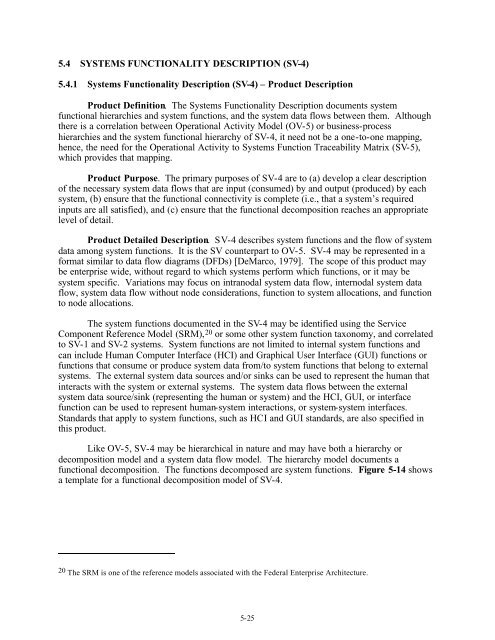DoD Architecture Framework Version 1.0, Volume 2 - AcqNotes.com
DoD Architecture Framework Version 1.0, Volume 2 - AcqNotes.com
DoD Architecture Framework Version 1.0, Volume 2 - AcqNotes.com
Create successful ePaper yourself
Turn your PDF publications into a flip-book with our unique Google optimized e-Paper software.
5.4 SYSTEMS FUNCTIONALITY DESCRIPTION (SV-4)5.4.1 Systems Functionality Description (SV-4) – Product DescriptionProduct Definition. The Systems Functionality Description documents systemfunctional hierarchies and system functions, and the system data flows between them. Althoughthere is a correlation between Operational Activity Model (OV-5) or business-processhierarchies and the system functional hierarchy of SV-4, it need not be a one-to-one mapping,hence, the need for the Operational Activity to Systems Function Traceability Matrix (SV-5),which provides that mapping.Product Purpose. The primary purposes of SV-4 are to (a) develop a clear descriptionof the necessary system data flows that are input (consumed) by and output (produced) by eachsystem, (b) ensure that the functional connectivity is <strong>com</strong>plete (i.e., that a system’s requiredinputs are all satisfied), and (c) ensure that the functional de<strong>com</strong>position reaches an appropriatelevel of detail.Product Detailed Description. SV-4 describes system functions and the flow of systemdata among system functions. It is the SV counterpart to OV-5. SV-4 may be represented in aformat similar to data flow diagrams (DFDs) [DeMarco, 1979]. The scope of this product maybe enterprise wide, without regard to which systems perform which functions, or it may besystem specific. Variations may focus on intranodal system data flow, internodal system dataflow, system data flow without node considerations, function to system allocations, and functionto node allocations.The system functions documented in the SV-4 may be identified using the ServiceComponent Reference Model (SRM), 20 or some other system function taxonomy, and correlatedto SV-1 and SV-2 systems. System functions are not limited to internal system functions andcan include Human Computer Interface (HCI) and Graphical User Interface (GUI) functions orfunctions that consume or produce system data from/to system functions that belong to externalsystems. The external system data sources and/or sinks can be used to represent the human thatinteracts with the system or external systems. The system data flows between the externalsystem data source/sink (representing the human or system) and the HCI, GUI, or interfacefunction can be used to represent human-system interactions, or system-system interfaces.Standards that apply to system functions, such as HCI and GUI standards, are also specified inthis product.Like OV-5, SV-4 may be hierarchical in nature and may have both a hierarchy orde<strong>com</strong>position model and a system data flow model. The hierarchy model documents afunctional de<strong>com</strong>position. The functions de<strong>com</strong>posed are system functions. Figure 5-14 showsa template for a functional de<strong>com</strong>position model of SV-4.20 The SRM is one of the reference models associated with the Federal Enterprise <strong>Architecture</strong>.5-25

















